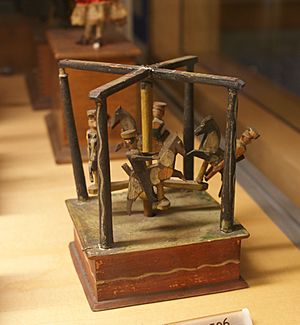Mechanical toy facts for kids
Mechanical toys are fun toys that move using mechanical energy. This means they are powered by things like rubber bands, springs, or flywheels. Depending on how they are built, these toys can do many different kinds of movements, from simple wiggles to very complex actions!
Contents
How Mechanical Toys Move
Mechanical toys use different types of motion to come to life. Understanding these movements helps us see how clever these toys are:
- Rotary motion: This is when something spins around in a circle, like the wheels on a toy car.
- Linear motion: This means moving in a straight line and then stopping, like a toy train going forward and then halting.
- Reciprocating motion: This is when something moves back and forth continuously in a straight line, like a saw blade.
- Oscillating motion: This is similar to reciprocating, but the movement is back and forth in a curve, like a pendulum swinging.
Inside the Toys: Mechanisms
Mechanical toys use several clever parts, called mechanisms, to make them move.
Cam Toys
Cam toys use a special part called a cam. Imagine a wheel that isn't perfectly round. As this uneven cam spins, it pushes another part called a cam follower up and down. This up-and-down motion then powers the toy. It's a smart way to turn a spinning motion into a different kind of movement!
Crank Toys
Crank toys often use cams inside too, but they allow for even more complex movements. When you turn a crank, it usually makes one specific action happen in the toy. If you turn the crank forward and then backward, the toy's action can also reverse.
Gear Toys
Gear toys use special wheels with teeth, called gear wheels. These gears fit together and help transfer power inside the toy. They can also change how fast or slow something moves, and even change the direction of the motion. You can power them by hand, or they might have a wind-up mechanism. By connecting many gears with different numbers of teeth, toy makers can create very complex and interesting movements.
Lever Toys
Lever toys use a simple machine called a lever. A lever helps to transmit and change movement. Think of a seesaw – that's a type of lever! In toys, levers can help make parts move up and down or side to side, often working with cranks and cams.
Pulley Toys
Pulley toys are a bit like gear toys, but instead of teeth, two parts are connected by a belt or a chain. Pulleys are great for transferring power over a longer distance with less energy loss than many gears. They can also change the angle, speed, and direction of a toy's movement.
Wind-up Toys
Wind-up toys are a classic type of mechanical toy. They usually have a metal spring inside that you tighten by turning a key or winding a knob. As the spring slowly unwinds, it releases energy. This energy is then transferred through gear wheels and pulleys to make the toy move.
Mechanical Toys in Learning
Mechanical toys are not just for fun; they are also great for learning! The European Union even had an education project called Clockwork objects, enhanced learning: Automata Toys Construction (CLOHE). This project showed how building mechanical toys can help students learn important skills like problem-solving and creative thinking.
These toys also help young children develop their motor skills, which are important for coordination and movement. Some schools even use mechanical toys as a fun way to teach these skills.
Mechanical toys have even been featured in films! A short Dutch documentary from 1972 called This Tiny World, which was about mechanical toys, even won an Academy Award.


